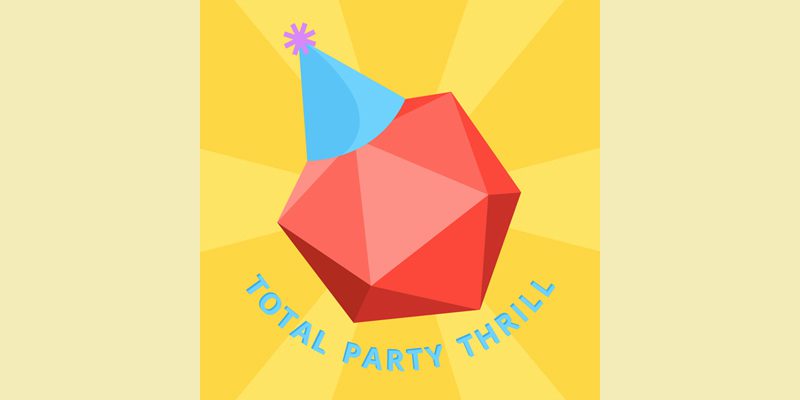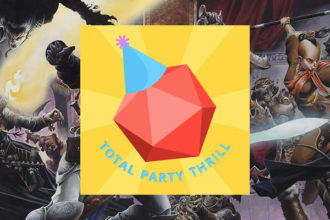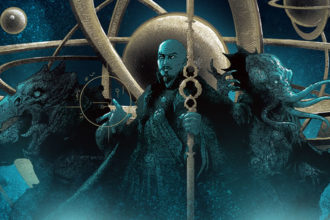An Interview with Shane & I-Hsien of Total Party Thrill

At Tribality, we’ve been interviewing some of the people who are behind all the awesome stuff that is being created for tabletop gamers — such as podcasts.
I started listening to the Total Party Thrill podcast at the start of 2016. I am really excited to bring you an interview with I-Hsien Sherwood and Shane Vaiskauskas, co-creators of the Total Party Thrill podcast. This podcast has great ideas for novice and experienced players and GMs. Each episode covers a particular aspect of game planning and playing, and they share tips and advice drawn from their own experience. Each episode also features the Character Creation Forge, where they build iconic character archetypes from outside traditional D&D using the D&D 5E rules.
Shawn: Before we talk about gaming and your podcast, can you both tell us a little bit about yourself?
Shane: In real life, I’m a vapid, 29-year-old New York City yuppie with a gym membership and an emotional investment in sports. I’m not really out of the “gamer closet” yet, but I recently stopped hiding my board game and RPG book collections when my fiancée’s friends come to our apartment. My mom listens to the podcast because she likes to hear my voice. I think she’s trying to tell me I should call her more often.
I-Hsien: I’m a typical Brooklynite writer — overeducated, overdressed, and over-35. Well-coiffed. I prefer politics to sports because it has actual consequences. Normally, I try to keep my nerdiness under wraps in mixed company. But the past few months have seen a marked increase in Star Wars misinformation, so it’s hard to keep my mouth shut around casual fans.
How did you first get into D&D and tabletop RPGs?
Shane: I actually started gaming with Warhammer 40k and Magic: the Gathering before I discovered D&D. I started reading InQuest magazine for its Magic price guides, and that introduced me to D&D and RPGs in general. Since those hobbies suck money out of your pockets far faster than a 12-year-old can mow lawns, I think I was 13 before I managed to grab the AD&D Core Rules 2.0 CD-ROM, but I never looked back.
I-Hsien: Say what you will about M:TG, but it got a lot of us into the hobby. I started playing Magic in the stairwell of my high school during the lunch period. That led me to the local comic book shop, Jolly Roger’s, and friendships with gamers who played AD&D every weekend in their parents’ basements. We went to different schools, so we never would have met otherwise. Of course, they started me off as the healer, but my forest gnome’s -4 AC bonus made me feel like a badass — a heady rush for an awkward 15-year-old.
Do you prefer being a gamemaster (GM) or a player?
I-Hsien: It took years before I was willing to try my hand at running a game, but now I love it as much as playing. It’s the difference between hearing a joke and telling a joke. Being intentionally funny is a lot more difficult, but success is more rewarding. And other times you just want to sit back and enjoy the show.
Shane: Both. I play RPGs for both the social and creative aspects, and I get my fix for either on both sides of the table. I-Hsien and I are lucky that every player in our group is also happy to GM, so we really get a choice. Sometimes I have this great idea for a game and I just want to run it. Sometimes someone else has an idea for a game that inspires a character I just have to play. Sometimes I end up rolling randomly and let the character grow on me from there. Either way, if I’m playing an RPG, I’m having fun.
When did you first take on the challenge of being a GM? How did it go?
I-Hsien: It was pretty awful, actually. I was playing in a 3.5 game that fizzled out. I wanted to see high-level play before 4e debuted, so I offered to run a level 15 one-shot, all splatbooks and options allowed. The party ended up including a Hellfire Warlock/Incarnate, a Frenzy Barbarian with the Feral template, a Ghostwise Whisperknife who threw 16 daggers a round, and a Vow of Poverty monk. I lost control as soon as I said “Roll initiative.” The only puzzle I included consisted of a terrible acronym riddle that required the spell Analyze Dweomer. Combat took so long that we went 3 sessions before they kindly asked me to just tell them how it ended. I’m marginally better now.
Shane: Despite reading all of the AD&D 2E books and building dozens of characters and monsters and whatnot in preparation for my first game, it wasn’t until high school and 3rd Edition that I got my friends together to actually play a game of D&D. I was the DM, so I promptly threw my friends into a gladiator pit and TPKed them with a bulette. Subsequent campaigns were equally (and rightfully) short-lived. I was an awful DM, but I guess we all had fun because we kept playing.
Do you have any advice for first time GMs?
Shane: Run a published adventure. These are great examples of how to organize your thoughts and ideas to prepare for a session, but keep in mind that it’s not the only way. Your first session probably won’t be great, and you’ll think it’s even worse, but you can’t learn if you don’t try. Shameless plug: this was the topic of Episode 28.
I-Hsien: Yeah, we get this question a lot, which inspired that episode. Accept that you’re going to screw up, and realize that you and your group can still have a ton of fun when you do. Don’t let our horror stories scare you off. You can’t become a good GM until you’ve been a bad one, so get started. Fight with the party, not for or against them.
Do you have any advice for first time players?
Shane: Always carry a 10-foot pole, and don’t crawl head first into the mouths of any green devil-face statues. But seriously, try to be creative and keep an open mind.
I-Hsien: Check for traps. Don’t split the party. It’s always the vizier. RPGs are cooperative games, so celebrate everyone’s crits and lament everybody’s natural 1s. Like any hobby, avoid toxic people. Don’t let in-game issues affect real life, and vice versa. If you don’t host, bring snacks to share.
What is your favorite tabletop RPG to run right now for a longer campaign?
Shane: D&D 5th Edition, and it’s not even close. It’s my favorite version of my favorite game, and the one I’m most invested in. For most games I run, I might know half of the mechanics. With D&D 5E, there’s so much mechanical conservation from 2nd and 3rd editions that I know it backwards and forwards. I feel like I’ve been playing it my entire life, so it’s easy to adjudicate, house rule, homebrew, and design for.
I-Hsien: I agree on all counts. There’s also a massive amount of 2nd and 3rd Edition and Pathfinder material that can be easily ported over, so old campaigns can live again. It’s not quite as easy to run on the fly as 4th Edition, but I feel much less constrained by the ruleset. It’s very hackable, while still being tough to truly screw up.
What is your favorite tabletop RPG to run right now for a one-shot or short campaign?
Shane: I’ve been running Dark Heresy 2nd Edition from Fantasy Flight Games for a few months, and I really like it. The system has some glaring flaws, but I just love the Warhammer 40k setting too much, and our group does a great job of embracing the grimdark almost to the verge of parody. I also GMed when we playtested Phoenix: Dawn Command from Keith Baker last year, so I’m really excited to give that another shot when it’s released, and I’m hoping I can convince I-Hsien to run it.
I-Hsien: That’ll be difficult, because my Bitter is about to return from his third death, and I really want to see what happens. I like Fantasy Flight’s Edge of the Empire, though more for a gritty Firefly game than Star Wars itself. Character creation is quick, and the strange dice rarely result in outcomes that are entirely good or bad — great for a campaign heavy on shades of gray.
How did you end up going from running games to recording a podcast?
Shane: I-Hsien and I used to share a 45-minute subway ride after game night each week, which we spent pretty much nerding out over D&D, tossing character ideas and mechanical oddities back and forth to each other. For example, we once debated whether or not D&D had faster-than-light travel on the basis of using readied actions and a few thousand minions to transport an object impossible distances in a single 6-second combat round. At the time we started talking about a podcast, we were also coming upon the end of a 3-year Eberron campaign that I-Hsien was running, and game night was moving to my apartment. A few weeks later, rather than lose our whimsical late-night subway conversations, we recorded our first episode. Six months later, we still meet at Mundangerous Studios (AKA my kitchen table) to record each week.
I-Hsien: I had already been thinking about writing up my campaign notes as a resource guide, because at that point very few GMs had been able to run 5e as long as I had. I hate typing, and I like talking, so here we are.
I’ve heard your favorite campaign setting is Eberron? What do you enjoy about it?
I-Hsien: Most fantasy settings use magic as a foundational principle, but few then extrapolate how that change would actually affect a society as thoroughly and believably as Eberron does. If fire can be conjured from fingertips, why wouldn’t someone have invented a steam engine? I also love that the gods are distant. Divine magic obviously works, but the gods don’t walk among mortals or tell them what to do. People with good intentions can legitimately disagree on matters of faith or politics, even start wars. It was born out of everything I loved about 3rd Edition D&D but reined in some of the epic-level excesses.
Shane: I just love how thoughtfully and purposefully assembled it is as a setting, especially in the way it embraces the ubiquity of magic without completely rejecting technology. The various analogues for real world concepts, like Dragonmarked Houses as stand-ins for multinational corporations or the cultural mirrors of the nations of Khorvaire, don’t strain my suspension of disbelief as much as the standard fantasy settings like Forgotten Realms. I also love that there’s a glaring mystery sitting in the center of the world — the Day of Mourning — that forces every DM to put her own spin on the setting.
You cover the ongoing adventures of your players each episode, mostly in the Mourning Glory campaign. What have you learned as a GM by revisiting your campaign each week in your recaps on the show?
I-Hsien: Many of the times I thought I was screwing up turned out to be great memories. I’ve also come to accept how solipsistic players can be. They remember things like hand-picked magic items, personal connections with NPCs, and custom epic destinies far more than carefully pruned lore or the true motivations of my brilliant antagonists, so now I put most of my efforts into the former. The hours I spent writing prophecies were totally worth it, though.
Do you have a favorite topic you covered in an episode? What topic received the most feedback from your listeners?
I-Hsien: We didn’t expect Episode 29 on playing non-human characters to be as popular as it was. I suppose inhabiting the persona of a monster or a faerie was what drew a lot of us to the game in the first place. The outline for that show was very minimal, so it was mostly improvised, and I think that comes across in the audio — in a good way. You can hear us have an epiphany about aarakocra or get lost on a tangent about dwarven gestation. It easily could have been twice as long, so we’re expanding it into a series.
Shane: In episode 11, we discussed the Social Contract. That’s a really important topic, and I think we did it justice. If you look on message boards and social media, you see so many “gaming horror story” problems really boil down to players not honoring their group’s Social Contract. I’m really proud of our message in that episode: only if everyone at the table feels respected and comfortable can everyone have fun. Communication is the key to this hobby.
Each week you build a character concept. Do you have a favorite character build?
I-Hsien: I find characters with abilities just slightly beyond the limits of reality to be the most compelling, so I’ve always had a soft spot for monks, though I’ve never actually made it all the way to Grandmaster of Flowers. Monk is also a great dip for nearly any character focused on melee or mobility. And I really appreciate the way the default flavor of the class expands the traditional medieval Eurocentrism of most fantasy settings.
Shane: I like playing devout characters because I’m not particularly religious in real life. I love the Holy Hand Grenade Paladin in 5th Edition, who seeks a worthwhile death in service of his deity. In this case, he chooses to measure “worthwhile” in terms of “punishment and death inflicted upon terrible, evil creatures.” Every time he fails to die, he considers it an affront to the worthiness of his cause.
What are the Thrillie Awards? How did you come up with the idea for the Thrillie Awards?
Shane: Short answer? We ripped off the ENnies. Long answer? We have to record episodes way in advance to keep a weekly schedule through the holidays. An award show is pretty easy to plan, especially when you don’t take it very seriously.
If someone is looking to branch out from D&D/Pathfinder and try a new game for a one-shot, do you have any recommendations?
Shane: Fiasco. It’s designed for one shots, gives everyone a chance to roleplay, doesn’t require a GM, and I always end up laughing so much my face hurts.
I-Hsien: Diplomacy (every game is a one-shot if you try hard enough). Generally, RPGs are collaborative, cooperative games, which is one thing I love about them. Diplomacy is a good outlet for the backstabbing and gentle weeping that otherwise might not get expressed.
What does Total Party Thrill have planned for the coming months?
Shane: We’ll be reviewing content from the Dungeon Master’s Guild. There’s so much available, but the ratings aren’t reliable, so it’s tough to find the best material. We’ll also be releasing some of the content we’ve created for our own games. And in November, I’ll be a “special guest” at AcadeCon.
I-Hsien: We’re also already rolling out new series on managing particular player profiles and playing non-human races, plus our setting briefings, which help groups decide if they want to play in a specific published setting. And of course, we’ll both be at GenCon this year, so look us up if you’re in town.
Thanks Shane and I-Hsien for taking the time for this great interview. Everyone please check out the Total Party Thrill podcast.



